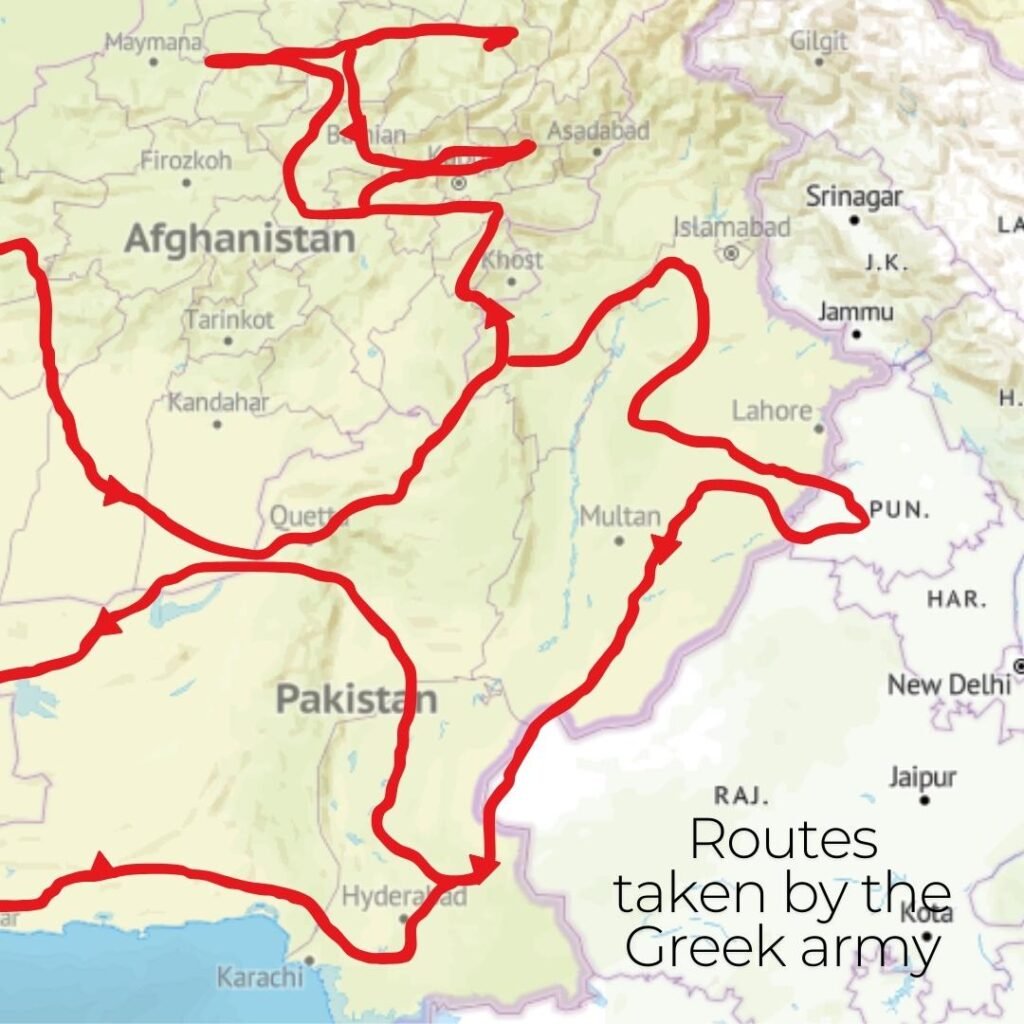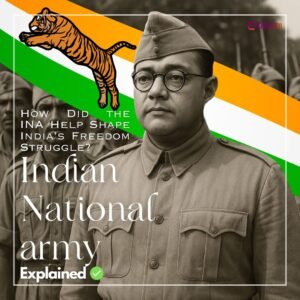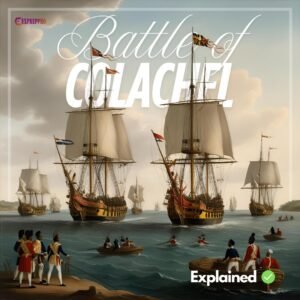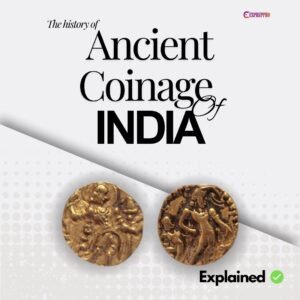
After the death of Mahapadma Nanda, an important event in the history of ancient India happened, i.e. the Greek invasion of India. In the spring of 327 B.C. (in some books, it is 326 B.C.), the Indian subcontinent was invaded by the famous Macedonian king and the conqueror of the ancient world, Alexander the Great. This Macedonian invasion brought many changes. For example, Alexander’s invasion opened communication between India and the Western countries.
Now, let’s look into the details of the Greek invasion of India or Alexander the Great’s invasion of India.
ALEXANDER’S CONQUEST
During the spring of 327 B.C. Alexander the Great and his army crossed Hindukush from Bactra to the plains of the Indus River. Before this event, he stayed in the Afghan region for three years. It is the most extended stay in any area of the whole campaign.
Before starting his military operations in the plain, he besieged the Sogdian rock in the highlands bordering Uzbekistan and Tajikistan. Another important event that happened during this period was the execution of his loyal follower, Clitus, by Alexander. This unfortunate incident occurred during a banquet at Samarkand or Maracanda.
Later, the Sogdian war was concluded by a marriage alliance with Roxane, the daughter of Oxyartes, a warlord.
FATE OF KING AMBHI AND OTHER RULERS
King Ambi, or King Omphis of Taxila, was one of the first Indian kings to pledge his support to the invading Greek army and Alexander.
Later, embassies from other kings also reached out to declare their support. However, some kings and non-monarchial clans offered stiff resistance to the invaders.
While he was planning for further conquest, there was a revolt in Peucelaotis or Pushkalavati. The revolt resulted in the killing of Astis, its ruler. Later, he was replaced by Sangaeus.
King Ambhi surrendered eighty talents of Indian punch-marked coins to Alexander as part of the surrender. Greek records mention these coins as Argentum Signatum.
Next, he moved his tropes north along the Kunar River or the Choaspes River towards Swat.
The city of Andaca was destroyed, and the inhabitants of Kunar escaped to the high mountains. It was from here that Alexander got his prize cattle.
The next unfortunate city was Aspasioi or Asvaka. After Asvaka, they entered Asmaka, or Assaceni, the country. The city of Massaga and its citizens faced notorious brutality. Then, the fate of the walled city of Ora changed (Ora is identified with Odigram).
Another city, Nysa (modern location is unknown), escaped from the attack due to luck. Acaphis, the chief of Nysa, convinced the attackers that the city of Nysa was the birthplace of a god, which made the city sacred. Luckily, due to the similarity of names, the Greek invaders linked the name to Dionysus and spared the town.
KING PORUS
Porus was the king who ruled the land between “Jhelum” or “Hydaspes” and “Chenab” or “Acesines“.
Apart from this, only his dynasty name is known. He belongs to the Puru tribe, and the rest of history is still unknown to us.
Alexander attacked Porus, which resulted in a legendary battle on the banks of Hydaspes.
BATTLE ON THE HYDASPES AND ALEXANDER’S BRILLIANCE
Porus and his army assembled on the Karri Plain, situated on the east bank of the Jhelum River, to defend Alexander’s army.
Alexander faced a dangerous problem for the first time- “Elephants“. He knew horses would get scared if they saw elephants while crossing the river. So, to avoid such a situation, he moved his cavalry twenty-seven kilometres upstream to a wooded island called Admana and crossed the river to attack Porus from the north. Porus’s brother “Spitaces” was sent upstream to a point opposite to counter them.
Alexander crossed the river after a heavy rainy night when circumstances eased off. Poru’s son defended with a force of chariots but failed. Chariots become useless because of the deep mud and heavy rain of the previous day.
At last, Porus surrendered. According to Arian, Porus lost 20000 soldiers and 3000 horse riders, all chariots were destroyed into pieces, and two sons of Porus, along with Spitaces, died in the battle. All the surviving war elephants were captured.
Alexander lost his horse, Bucephalas, in this battle.

PORUS AND ALEXANDER’S DECISION
When Alexander asked Porus how he expected to be treated, the brave king replied, ” Like a king“. This answer pleased Alexander.
Porus kingdom and new territories were restored under Alexander’s suzerainty. Porus remained loyal to his new master government until the death of Alexander.
To celebrate his victory, Alexander founded two cities, Nicaea and Bucephala. Nicaea means victory, and Bucephala is in memory of his favourite horse, Bucephalas.
To ensure the safety of his new territory, Alexander placed adequate Greek garrisons in cities founded by himself. This prevented any revolts against the master government.
CONTROL OVER SOPHYTES
Sophytes ruled the mountain country located in the salt range.
During the campaign, the Greeks faced astonishing courage from their soldiers and their guard dogs. These guard dogs fought like lions.
After submission, Alexander allowed him to rule. Later, he even struck a coin in his name, Sophytes. This continued even after fourteen years.
This coin was similar to Seleucus’s coins. Its reverse shows a cock and a caduceus. If this is a portrait, it may be the first royal portrait on a Hellenistic coin minted in the Indian sub-continent.
CATHAEI or KATHIS OF KATHIAWAR
Kathis or Cathaei was a gana-sangha or autonomous group.
Kathisans held beauty in great esteem. They examined every infant medically, and if they found any deformations, the infant would be killed.
Alexander created a blockade and constructed a stockade around the city with a gap. The attackers slaughtered all defenders and people who tried to escape through this gap without mercy.
Interestingly, Porus was also a part of this campaign. At last, the people of Cathaei surrendered.
KINGDOMS OF PHEGEUS or PHEGELAS
They welcomed the Greeks at Phagwara and surrendered without a fight.
After conquering this kingdom, Alexander moved through Gandaridai and reached the area of the Ganges. He even sent his mother a letter telling her he had reached the Ganges. But in reality, he did not see Ganga.
SIBOI AND AGALASSIANS
Alexander received a hostile reception from both. Both fought gallantly. The Agalassians at first repulsed Alexander.
Later, the Greeks unleashed terror and a series of massacres. At last, the Agalassians set fire to their houses along with their women and children. This is considered as the earliest record of Jauhar.
SAMBUS
Sambus was a self-appointed satrap for the hillmen. According to Arrian, they surrendered, but Diodorus says Alexander eliminated them.
MALLOI AND OXYDRACAE UNDER ALEXANDER’S VENGEANCE
Malavas and Ksudrakas are war-like tribes, and both gave a hostile reception to the invaders. Both decided to defend themselves together.
Alexander prevented the Oxydracae from joining the confederacy. So they surrendered.
Malloi or Malvas faced the attack alone and faced a dreadful record of inhuman manslaughter.
Ksatri of Manu, Vasati, Sodrai and Massonoi submitted to invaders. We do not have many details about their conditions.
CONCLUSION OF ALEXANDER’S CAMPAIGN
Alexander’s success was halted when we were on the banks of the Beas River. The primary reasons were:
- Beyond Beas, it is the Nanda territory, which is an entirely unknown terrain to the Greeks. They had already faced the valour of small kingdoms. So, going for a campaign in a large kingdom will be challenging.
- Greek soldiers showed unwillingness to proceed further to an unknown area. Moreover, continuous fighting exhausted them.
So Alexander decided to leave India temporarily in 325 B.C. His plan was to come to India again and restart his invasion later. But two years later, he died in Babylon.
ALEXANDER’S GREEK SATRAPS AND THEIR ADMINISTRATION
He appointed several governors like Philip over the region above Sind up to Kabul and Peithon in Sind to control the princes of captured territories. King Porus was appointed the area’s ruler between Jhelum and the Chenab. King of Taxila and Abhisara were also allowed to rule under master government supervision. Greek army stationed at strategic locations helped to control the capture area effectively. After the death of Alexander, the Greek power in the Indian subcontinent gradually vanished into thin air.
WHAT ARE THE RESULTS OF GREEK INVASION IN INDIA?
- Greek army demonstrated the importance of a regular, disciplined and structured army to Indians. Indians realised their weakness.
- The Indian subcontinent was brought into direct contact with the European countries.
- Coins similar to Greek coins were minted in India.
- The contact established helped for knowledge transfer between the two countries.



